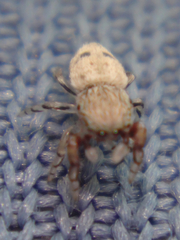Trombidiidae

Arachnida Trombidiidae is a family of mites belonging to the order Trombidiformes. Known commonly as red velvet mites, these arachnids are recognized for their striking appearance and ecological roles.
Key Characteristics:
- Appearance: Members of this family are characterized by their vibrant red coloration and velvety texture, which is due to the dense covering of setae (hair-like structures) on their bodies.
- Size: They range in size from minute species to those several millimeters long, easily visible to the naked eye.
- Lifecycle: The life cycle of Trombidiidae includes several stages: egg, larva, nymph, and adult. Larvae are often parasitic, while adults are typically free-living predators.
Ecological Role:
- Predators: As adults, red velvet mites play a critical role as predators of small arthropods and insect eggs, helping to control pest populations.
- Parasitism: In their larval stage, some species exhibit parasitic behavior, often attaching to insects or other arthropods as hosts.
Habitat:
- Red velvet mites are typically found in soil, leaf litter, or under stones in various environments, including forests, grasslands, and occasionally in arid regions.
- They are particularly noticeable after rain, when they emerge from the ground.
Significance in Comunidad Valenciana:
- In the Comunidad Valenciana, these mites contribute to the local ecosystem by participating in soil aeration and nutrient recycling as they move through the soil and decomposing organic matter.
- They are also interesting to observe, given their bright coloration and unique life cycle.







